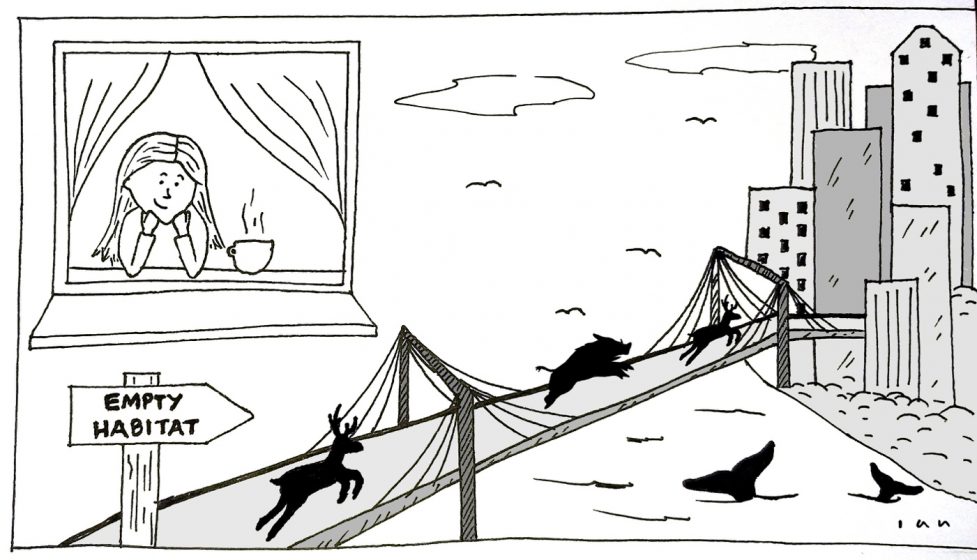
Within days of stay-at-home orders, wildlife have been stunningly and unexpectedly sighted in major urban centers globally—including animals that are threatened or endangered. This has captivated the general public and scientists alike. Mountain lions in the USA, wild boars in Italy, manatees in Costa Rica, a leatherback sea turtle, a jaguar and vulnerable great curassows in Mexico—all of these have been seen in cities and resort towns recently, potentially driven by the lack of humans3–10. And at the same time, some animals who rely on human waste, such as jackals in Israel, and feeding by humans, such as Nara Deer in Japan and macaques in Thailand, have been going further into cities in search of food 11–13. Chronicling these sightings, rigorously examining how animals’ behaviors change as people leave city centers, and then investigating what happens once humans begin re-populating our cities will not only help us answer fundamental questions in animal behavior and urban ecology, but will also help us rethink how wildlife can live within our cities, and how resilient these populations truly are.
Human lockdowns have had positive effects on the one side, controlling the spread of the new SARS-CoV-2 and as side effect, decreasing greenhouse gas emissions, but has also had important negative effects, including the devastation on so many people’s lives through the sheer lack of means for the most basic needs of food and shelter. With the social and economic aftermath of lockdowns being yet unquantifiable, COVID-19 lockdowns will not only leave a mark in our history books but will obligate us to rethink many aspects of our current way of living—for instance, with nature. With the almost immediate responses of wildlife to our absence in cities, many of us start to reconsider the type of world we want to live in, and whether and how that includes the majestic creatures who, for much of the last few centuries, have mostly made their lives around us humans.
Eleanor Diamant, Ian MacGregor-Fors, and Pamela Yeh
Los Angeles, Xalapa, and Los Angeles
*Sightings shared on Twitter were verified by our team by contacting the observer directly.
References:
- Grimm, N. B. et al. Global Change and the Ecology of Cities. Science. 319, 756–760 (2008).
- McKinney, M. Urbanization, Biodiversity, and Conservation. Bioscience 52, 883–890 (2002).
- Threatened bird species spotted in Cancun park days after mandatory closure. Riviera Maya News (2020).
- Sea turtle season officially begins for Cancun with arrival of leatherback. Riviera Maya News (2020).
- Lee, R. [@robinnelee]. So, um, my mountain lion came back. Maybe we’ll hold off on that egg hunt… #coronapocalypse #QuarantineLife [Tweet]. (2020).*
- Lee, R. [@robinnelee]. Waking up to a mountain lion in the backyard was the Coronapocalypse plot twist I did not see coming. [Tweet]. (2020).*
- Iyer, V. After mountain lions wandered through Boulder, officials unsure how sheltering will impact wildlife. The Denver Post (2020).
- Bressan, D. Animals Roam Freely In Italian Cities With Humans In Lockdown. Forbes (2020).
- Carrasco Fuentes, F. ¡Inédito! Jaguar se pasea libremente en Hotel Bahía Príncipe tras su cierre por coronavirus. Quinta Fuerza (2020).
- Donaire, M. With The Worldwide Lockdown Wildlife Is Making A Comeback Retaking Its Original Habitats. The Costa Rica News (2020).
- Gilad, M. & Vaknin, O. IN PHOTOS: With Israelis in Coronavirus Isolation, Jackals Are Taking Over Tel Aviv’s Main Park. Haaretz (2020).
- Evans, G. Deer in Japanese city forced to venture outside of parks in search of food as tourist numbers drop. indy100 (2020).
- Thaitrakulpanich, A. Lopburi’s Monkeys Food War Blamed on Plunge in Tourism. Khaosod English (2020).

about the writer
Ian MacGregor-Fors
Ian MacGregor-Fors is a researcher at INECOL (Mexico). His interests are broad, but he focuses on the responses of wildlife species to urbanization.

about the writer
Pamela Yeh
My lab is interested in measuring, understanding, and predicting the ecological and evolutionary trajectories of populations when they encounter novel environments, particularly environments with multiple disturbances or stressors.












Add a Comment
Join our conversation